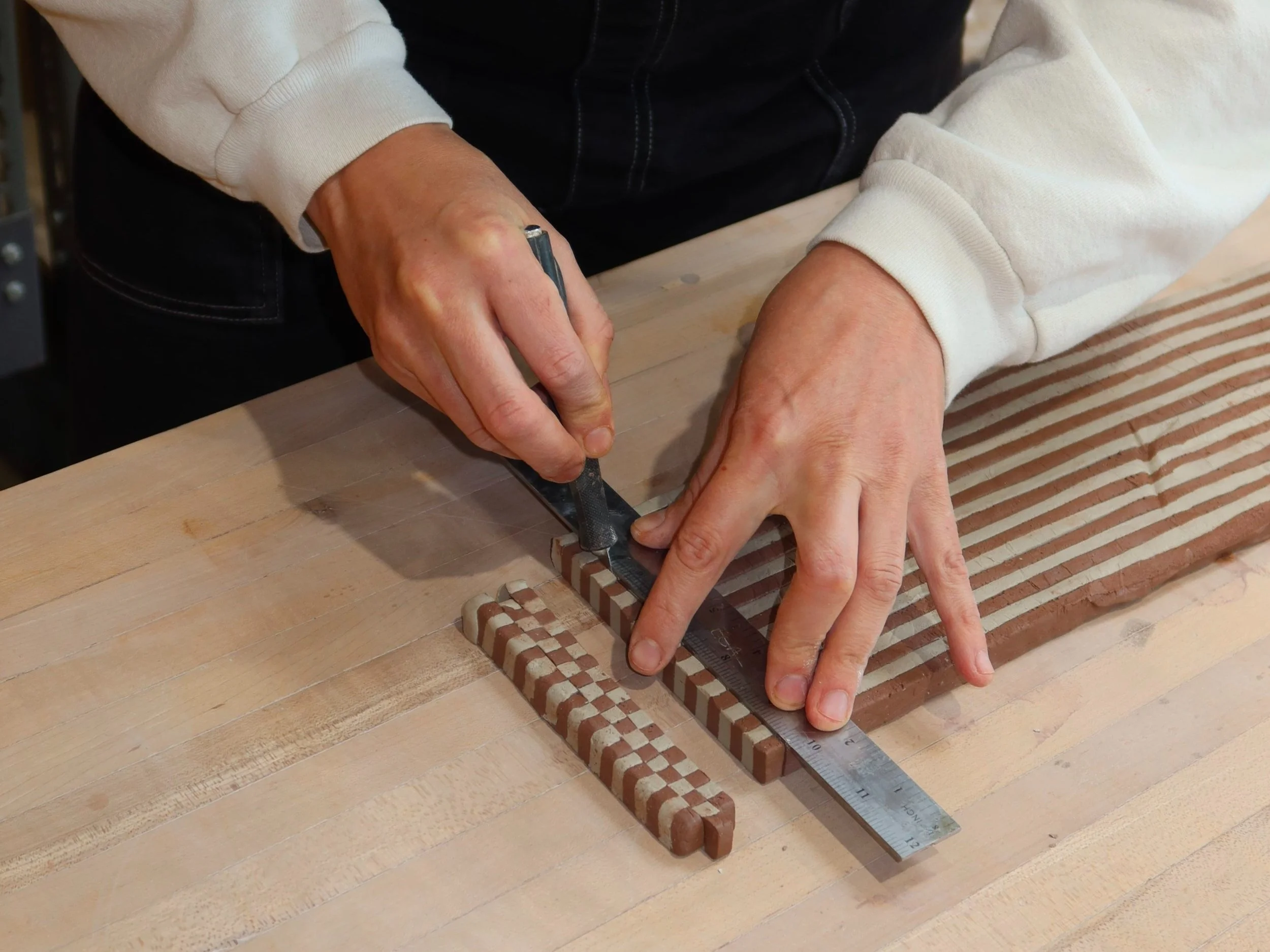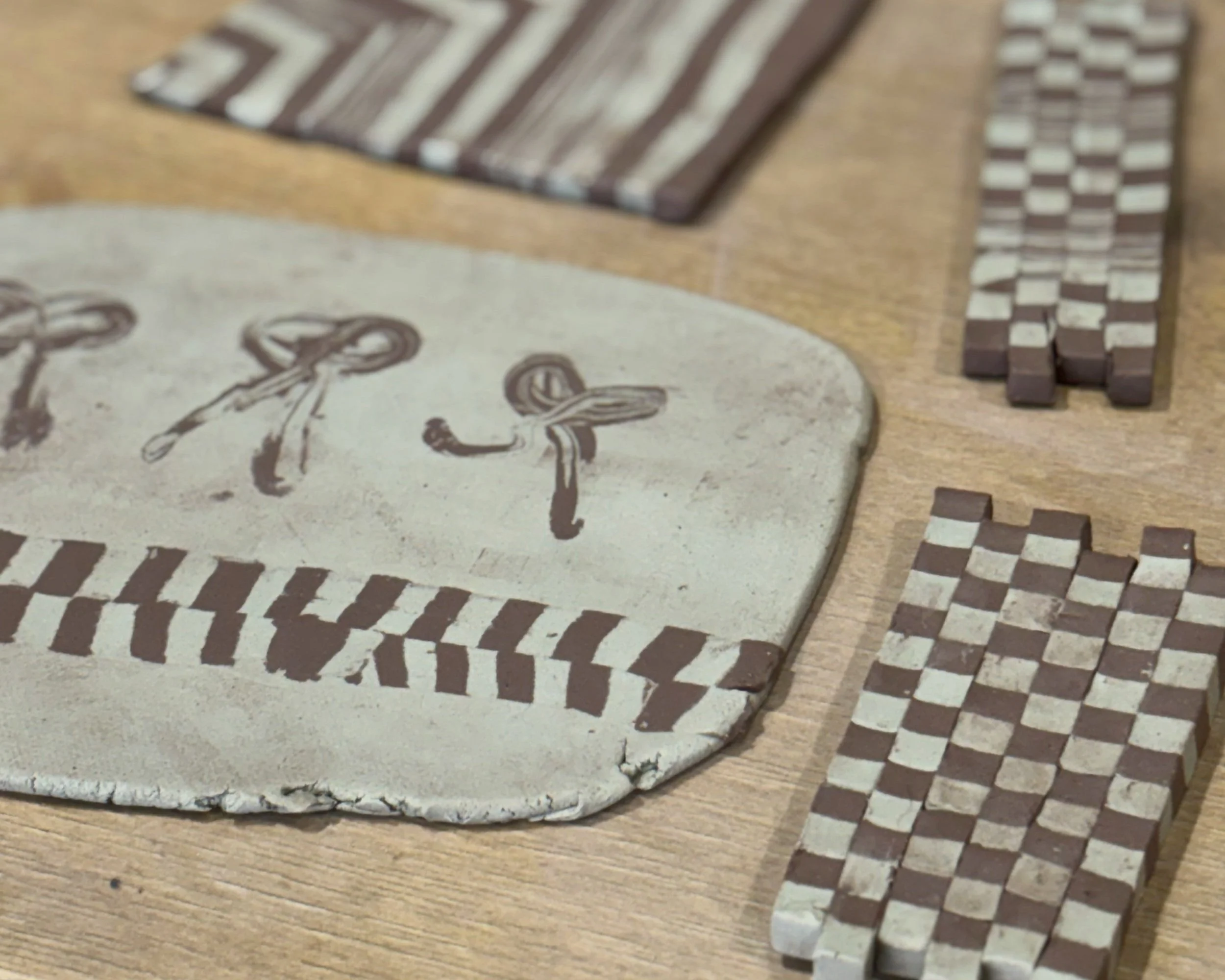Nerikomi: Creating Patterns with the Natural Colors of Clay
Written by Ava DeCapri
Nerikomi is a traditional Japanese technique that involves layering, stacking, and slicing colored clays to create intricate, patterned designs. While many artists begin with stained clays, at Tao of Clay, we focus on the natural palette of ceramic materials—clays that speak for themselves.
I discovered Nerikomi through trial and error. As I experimented with different clay bodies in the studio, I accumulated scraps in a range of natural tones. Rather than discard them, I began exploring ways to combine them, letting the unique character of each clay come through. I’ve always been drawn to the inherent beauty of raw, unglazed clay. Nerikomi became a natural extension of that appreciation.
Many clays become food-safe even without glaze (a porosity lower than 3%is considered food safe). This information opened up a new path for me: creating functional wares that do not require a glazed surface, allowing the clay body to be experienced more directly. After firing I found the surface revealed a tactile, almost stone-like quality and became more connected, more elemental than even the most matte glaze. The effect is subtle, but to me, it felt like a more intimate conversation with the material when Iwas able to engage with the unglazed and fully fired surface.
A fellow potter who was working at The Digs Studio in Chicago—Rachel Brianna of Handheld Ceramics—helped deepen my understanding of Nerikomi. Their contemporary approach to pattern and form, and their insight into surface finishing techniques like quartz sealer (often used for countertops), gave me new tools for making unglazed pieces more functional and durable. While optional, sealing a polished surface can be a beautiful, food-safe alternative to glaze.
As I developed my own Nerikomi practice, I found it to be both soothing and creatively energizing. The process invites a balance between structure and spontaneity. Scraps from one project became the seed of the next, and what began as a planned pattern often evolved naturally into something unexpected. It’s a rhythmic, intuitive way of working—one that encourages both control and letting go.
Teaching Nerikomi at Tao of Clay
In our Nerikomi workshops at Tao of Clay, I guide students through the foundational techniques ensuring strong adhesion between layers, avoiding cracking, and exploring traditional patterns. These techniques are practiced before encouraging individual exploration. We aim to build a reliable process, and then give ourselves permission to break it when a new pattern or discovery emerges.
This class is especially well-suited to beginners. It introduces students to different clay types and properties in a hands-on, accessible way. We start by creating patterned slabs, which are then formed into cups using a simple template. By limiting form choices, we can focus on surface design—every student builds the same cup, but no two cups look alike.
It’s a perfect example of how hand-building allows each person’s creative voice to shine through, no matter their experience level.
A Brief History of Nerikomi
While Nerikomi is a modern Japanese term, marbled clay techniques have ancient roots. Early examples appear in Egypt, China, and the Roman Empire, eventually influencing European agateware in places like Stoke-on-Trent, England.
In Japan, marbled ceramics can be traced to the Momoyama (1568–1600) and Edo (1603–1868) periods, as well as in mingei folk traditions. The term Nerikomi began gaining popularity in the 1970s, notably through the work of Matsui Kousei and a Nescafé ad campaign featuring Yusuke Aida’s Nerikomi coffee cups.
Though the technique is globally historic, Nerikomi today often refers to the Japanese approach to layering, cutting, and composing colored clays into intricate patterns. In the West, Nerikomi gained traction in the 20th century as studio potters looked beyond surface glazes and began exploring the clay body itself as a medium for design.
General Steps of Nerikomi
1. Color Your Clay
While some artists use mason stains to color porcelain or white stoneware, our workshops focus on the rich variety of natural clay tones that are earthy, elegant, and expressive.
2. Layer and Stack
Roll out slabs, stack and layer them to form patterned blocks. Even simple stripes or repeating scraps can generate beautiful, intentional-looking designs.
3. Slice the Pattern
Cut thin slices from your block and use them to form new slabs, or apply them to a backing slab.
4. Form Your Work
We use templates to turn the patterned slabs into functional forms.
5. Dry, Bisque, and Sand
After bisque firing, sand the surface using fine wet/dry sandpaper or blocks to refine and reveal the pattern.
6. Glaze or Seal (Optional)
For clay bodies that do not vitrify below 3% porosity, a clear glaze is necessary for food-safe use. Alternatively, after the final firing you can apply a quartz sealer to protect unglazed surfaces.
Key Tips for Working with Nerikomi
1. Clean Workspace = Crisp Patterns
Keep your hands, tools, and surfaces clean. Stray clay smudges can distort your design.
2. Strong Adhesion Is Crucial
To bond slices to slabs, sandwich your pieces between fine-thread-count sheets and gently roll, misting lightly with water to aid adhesion. Rotate frequently to avoid distortion.
3. Match Moisture & Shrink Rates
Use clay bodies with similar shrinkage rates. If clays are at different moisture levels, let them rest wrapped in plastic to equalize before slicing or forming.
4. Use the Right Tools
A taut wire cutter or sharp blade helps maintain clean lines. A rolling pin, mist spray, and high-thread-count sheets are essential.
5. Finish with Care
Post-bisque sanding with fine grit (start at 400, go up to 1000) enhances the surface and lets the patterns pop. You are not removing material—just refining texture.
Learn Nerikomi at Tao of Clay
We’re excited to share this timeless and tactile process with our community. Our Nerikomi workshops invite students to work with intention and curiosity, using clay’s natural palette to create bold and subtle designs. You’ll leave with a deeper understanding of the material and a piece that reflects both tradition and your personal touch.
Whether you are new to clay or a seasoned ceramicist, this workshop is a great way to expand your skills, connect with the material, and explore a beautifully expressive technique.
Upcoming Workshop Info:
Sign up for our next workshop session—spaces fill quickly! Sign up on our website or stop by the studio for more information.


